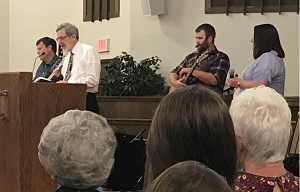The “Times of the Gentiles” is a period of human history named by the Lord Jesus Christ according to Luke 21:24. We notice from this Scripture that during this particular period Jerusalem, the capital city of the Jews, is “trodden down of the Gentiles.” We see also that this condition must prevail only “until the times of the Gentiles be fulfilled.” Therefore, the Jews have a scriptural right to “look up” and lift up their heads in anticipation of the glory that is coming to them and to their nation at the end of the times of the Gentiles. The Lord has made promises to them that He will give them “signs in the sun, and in the moon, and in the stars” and that among the peoples of the earth there shall be distress, “men’s hearts failing them for fear, and for looking after those things which are coming on the earth.” He declares that these certain signs will immediately precede the coming of the Son of man “in a cloud with power and great glory.” Furthermore, His imperative decree is that when these things “begin to come to pass” then Israel may know assuredly that the time of her “redemption draweth nigh” (Luke 21: 25-28).
The present day “trodden down” condition of Israel is due to God’s just and righteous judgment upon her. Daniel said, “Yea, all Israel have transgressed thy law, even by departing, that they might not obey thy voice; therefore the curse is upon us, and the oath that is written in the law of Moses, the servant of God, because we have sinned against him. And he hath confirmed his words, which he spake against us, and against our judges that judged us, by bringing upon us a great evil: For under the whole heaven hath not been done as hath been done upon Jerusalem” (Daniel 9: 11-12). These words were written by Daniel while he was in Babylonian captivity and they form a part of his prayer which he prayed for himself and for his people just before God revealed unto him their hope and glory through Christ the King at the end of the 70 weeks (Daniel 9:24).
From Nebuchadnezzar to the Anti-Christ
The kingdom of Babylon had its beginning under the leadership of Nimrod (Genesis 10:9-10) and is therefore one of the oldest kingdoms of the world. Nebuchadnezzar was king of Babylon when God took the reins of government out of the hands of the nation of Israel and gave them over to the Gentiles. He was the first king of the Gentiles within that particular period spoken of by our Lord as “the times of the Gentiles.” The last king of this period will be the Anti-Christ. Nebuchadnezzar was a world ruler of unlimited power and the Anti-Christ will be a world ruler of unlimited power. A great bridge must have a strong foundation or buttress at each end, otherwise it could never span the chasm. In like manner the Gentile governments spanning the times of the Gentiles had a strong and powerful king at the beginning and will have even a stronger one at the end. As God deals with the various Gentile kingdoms He only records His dealings with those that come in direct contact with His people Israel. For instance, the successive kingdoms mentioned in Daniel’s prophecy are reckoned only as they obtain possession of Jerusalem. They existed before that; and each, in turn, was absorbed in the one that succeeded. At the very close of the Gentile times, the beast of Revelation 13:1 will be in power, and his “ten horns” or “ten kings” will join with him to “make war with the Lamb, and the Lamb shall overcome them: for he is Lord of Lords, and King of Kings” (Revelation 17:12-14).
The Meaning of the “Great Image”
King Nebuchadnezzar dreamed a dream which troubled his spirit. He had forgotten this dream and his magicians, astrologers, sorcerers, and Chaldeans could not bring it back to his mind. Daniel was brought before the king and the king said unto him, “Art thou able to make known unto me the dream which I have seen, and the interpretation thereof? Daniel answered in the presence of the king and said, the secret which the king hath demanded cannot the wisemen, the astrologers, the magicians, the soothsayers, shew unto the king; but there is a God in heaven that revealeth secrets, and maketh known to the king Nebuchadnezzar what shall be in the latter days, Thy dream, and the visions of thy head upon thy bed, are these; as for thee, O king, thy thoughts came into thy mind upon thy bed, what should come to pass hereafter: And he that revealeth secrets maketh known to thee what shall come to pass. But as for me, this secret is not revealed to me for any wisdom that I have more than any living, but for their sakes that shall make known the interpretation to the king, and that thou mightest know the thoughts of thy heart” (Daniel. 2: 26-30).
It is important to note that the revelation concerning this dream came from the God of heaven, and that the dream itself had to do with the latter days and things that should come to pass hereafter.
In verses 31 to 35 of this same chapter the forgotten dream is dealt with. “Thou, O king, sawest, and behold a great image, This great image, whose brightness was excellent, stood before thee; and the form thereof was terrible. This image’s head was of fine gold, his breast and arms of silver, his belly and his thighs of brass, his legs of iron, his feet part of iron and part of clay. Thou sawest till that a stone was cut out without hands, which smote the image upon his feet that were of iron and clay, and brake them to pieces. Then was the iron and the clay, and the brass, and the silver, and the gold, broken to pieces together, and became like fine chaff of the summer threshingfloors; and the wind carried them away, that no place was found for them: and the stone that smote the image became a great mountain, and filled the whole earth.”
The interpretation of this dream is clearly set forth in verses 36 to 45. The image whose brightness was excellent, and whose form was terrible, represents four Gentile kingdoms that are now historic and one that is yet future. Nebuchadnezzar and his Babylonian kingdom was represented by the head of gold; Medo-Persia, which according to history succeeded Babylon by occupying Jerusalem was represented by the breast and arms of silver; “the third kingdom of brass” represented the Grecians; the legs of iron represented the Romans; and the feet with the ten toes part of iron and part of clay represent the future kingdom of the Anti-Christ with the ten kings serving under him as suggested in Revelation 17:12-13.
The Doom of the Top-Heavy Image
is certain. It is just as top-heavy as the Gentile governments which it represents. The head of the image was made of gold which has a specific gravity of 19.3. The silver in the breast and arms has a specific gravity of 10.51, the brass in the belly and thighs 8.5, the iron in the legs 7.6, and the clay in the feet and toes only 1.9. Such a top-heavy construction could never survive its own weight. It must tumble and fall. Gentile governments through the times of the Gentiles have been and will continue to be short lived because of their top-heaviness.
The iron, the clay, the brass, the silver, and the gold, is to be “broken to pieces together.” Thus we see that the kingdom of the Anti-Christ will possess the characteristics of all the former kingdoms represented by the different portions of the image. The “stone” which is to be cut out of the mountain without hands will smite the image “upon his feet.” That is, the smiting will take place in the time represented by the feet and toes. The ten toes are referred to as kings in Daniel 9:44. And it is “in the days of these kings” that the God of heaven shall set up a kingdom which shall never be destroyed. As I understand the Scriptures, the “ten toes” of the image, and the “ten horns” of the beast represent the same ten kings. These kings shall “have one mind, and shall give their power and strength unto the beast” (Revelation 17:12).
The “great mountain” which shall fill the whole earth (Daniel 2:35) represents the government of Jesus Christ during the millennium. It is “the mountain of the Lord’s house” spoken of in Isaiah 2:2, and it shall be established “in the top of the mountains, and shall be exalted above the hills; and all nations shall flow to it.” This will be the time when God shall hand the reigns of government back to His people Israel and the “times of the Gentiles” shall be no more.
Jerusalem, which is now trodden down of the Gentiles, shall be redeemed when the times of the Gentiles are fulfilled. God hath said, “I will turn my hand upon thee, and purely purge away thy dross, and take away all thy tin: and I will restore thy judges as at the first, and thy counsellors as at the beginning: afterward thou shall be called, the city of righteousness, the faithful city. Zion shall be redeemed with judgment and her converts with righteousness. And the destruction of the transgressors and of the sinners shall be together, and they that forsake the Lord shall be consumed” (Isaiah 1:25-28).
Surely this redemption spoken of by the prophet “draweth nigh.” It certainly seems that the signs of the times point clearly to the near realization of Israel’s hope. Down trodden Jerusalem and her children may well begin to “look up” and lift up their heads.
The church, which is the body of Christ, may be caught out and up and into glory just any moment; and when the church goes up, the 70th week of Daniel will begin and after the brief period of less than seven years the tribulation worn remnant of Israel will look upon Him whom they pierced and receive Him as King of Kings and Lord of Lords.
We, as members of the body of Christ, may scripturally join with John on the Isle of Patmos and say, “Even so, Come, Lord Jesus.”


